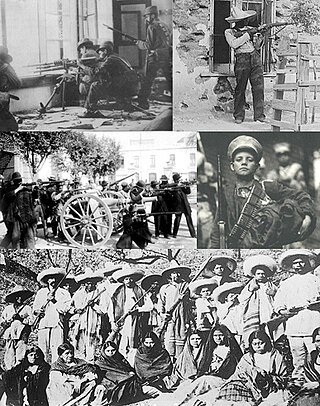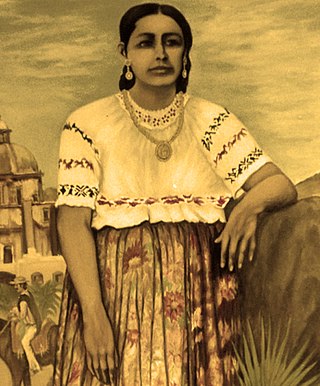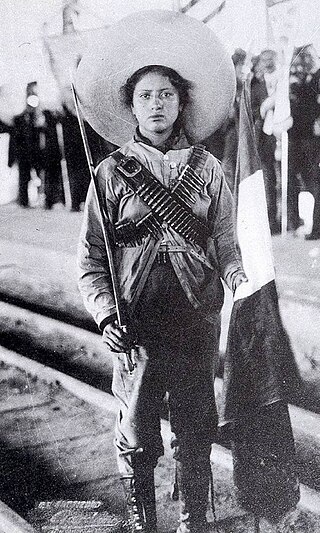
The Mexican Revolution was an extended sequence of armed regional conflicts in Mexico from approximately 1910 to 1920. It has been called "the defining event of modern Mexican history". It resulted in the destruction of the Federal Army and its replacement by a revolutionary army, and the transformation of Mexican culture and government. The northern Constitutionalist faction prevailed on the battlefield and drafted the present-day Constitution of Mexico, which aimed to create a strong central government. Revolutionary generals held power from 1920 to 1940. The revolutionary conflict was primarily a civil war, but foreign powers, having important economic and strategic interests in Mexico, figured in the outcome of Mexico's power struggles; the United States involvement was particularly high. The conflict led to the deaths of around three million people, mostly combatants.

La Cucaracha is a popular Mexican folk song about a cockroach who cannot walk. The song's origins are unclear, but it dates back at least to the 1910s during the Mexican Revolution. The song belongs to the Mexican corrido genre. The song's melody is widely known and there are many alternative stanzas.

"La Adelita" is one of the most famous corridos of the Mexican Revolution. Over the years, it has had many adaptations. This particular version of the ballad was inspired by a Chihuahuense woman who joined the Maderista movement in the early stages of the Revolution and fell in love with Madero. She became a popular icon and the source who documented the role of women in the Mexican Revolution; she gradually became synonymous with the term soldadera, who became a vital force in the Revolutionary War efforts due to their participation in the battles against Mexican government forces.

Soldaderas, often called Adelitas, were women in the military who participated in the conflict of the Mexican Revolution, ranging from commanding officers to combatants to camp followers. "In many respects, the Mexican revolution was not only a men's but a women's revolution." Although some revolutionary women achieved officer status, coronelas, "there are no reports of a woman achieving the rank of general." Since revolutionary armies did not have formal ranks, some women officers were called generala or coronela, even though they commanded relatively few men. A number of women took male identities, dressing as men, and being called by the male version of their given name, among them Ángel Jiménez and Amelio Robles Ávila.

Camp followers are civilians who follow armies. There are two common types of camp followers; first, the wives and children of soldiers, who follow their spouse or parent's army from place to place; the second type of camp followers have historically been informal army service providers, servicing the needs of encamped soldiers, in particular selling goods or services that the military does not supply—these have included cooking, laundering, liquor, nursing, sexual services and sutlery.
This timeline of women in warfare and the military (1900–1945) deals with the role of women in the military around the world from 1900 through 1945. The two major events in this time period were World War I and World War II. Please see Women in World War I and Women in World War II for more information.

The División del Norte was an armed faction formed by Francisco I. Madero and initially led by General José González Salas following Madero's call to arms at the outbreak of the Mexican Revolution in 1910. González Salas served in Francisco I. Madero's cabinet as Minister of War, but at the outbreak of the 1912 rebellion by Pascual Orozco, González Salas organized 6,000 troops of the Federal Army at Torreón. Orozquista forces surprised González Salas at the First Battle of Rellano. They sent an explosives packed train hurtling toward the Federales, killing at least 60 and injuring González Salas. Mutinous troops killed one of his commanders and after seeing the officer's body, González Salas committed suicide.
Las Adelitas de Aztlán was a short-lived Mexican American female civil rights organization that was created by Gloria Arellanes and Gracie and Hilda Reyes in 1970. Gloria Arellanes and Gracie and Hilda Reyes were all former members of the Brown Berets, another Mexican American Civil rights organization that had operated concurrently during the 1960s and 1970s in the California area. The founders left the Brown Berets due to enlarging gender discrepancies and disagreements that caused much alienation amongst their female members. The Las Adelitas De Aztlan advocated for Mexican-American Civil rights, better conditions for workers, protested police brutality and advocated for women's rights for the Latino community. The name of the organization was a tribute to Mexican female soldiers or soldaderas that fought during the Mexican Revolution of the early twentieth century.

The Soldiers of Pancho Villa is a 1959 Mexican epic historical drama film co-written, produced, and directed by Ismael Rodríguez, inspired by the popular Mexican Revolution corrido "La Cucaracha". It stars María Félix and Dolores del Río in the lead roles, and features Emilio Fernández, Antonio Aguilar, Flor Silvestre, and Pedro Armendáriz in supporting roles.
Josefina Niggli was a Mexican-born Anglo-American playwright and novelist. Writing about Mexican-American issues in the middle years of the century, before the rise of the Chicano movement, she was the first and, for a time, the only Mexican American writing in English on Mexican themes; her egalitarian views of gender, race and ethnicity were progressive for their time and helped lay the groundwork for such later Chicana feminists as Gloria Anzaldúa, Ana Castillo and Sandra Cisneros. Niggli is now recognized as "a literary voice from the middle ground between Mexican and Anglo heritage." Critic Elizabeth Coonrod Martinez has written that Niggli should be considered on a par with such widely praised Spanish-language contemporaries as Mariano Azuela, Martín Luis Guzmán and Nellie Campobello. She is thought to be the only Mexican-American woman to have a theatre named after her, the Niggli Studio Theater at Western Carolina University.
The status of women in Mexico has changed significantly over time. Until the twentieth century, Mexico was an overwhelmingly rural country, with rural women's status defined within the context of the family and local community. With urbanization beginning in the sixteenth century, following the Spanish conquest of the Aztec empire, cities have provided economic and social opportunities not possible within rural villages. Roman Catholicism in Mexico has shaped societal attitudes about women's social role, emphasizing the role of women as nurturers of the family, with the Virgin Mary as a model. Marianismo has been an ideal, with women's role as being within the family under the authority of men. In the twentieth century, Mexican women made great strides towards a more equal legal and social status. In 1953 women in Mexico were granted the right to vote in national elections.

Antonia Nava de Catalán was a heroine of the Mexican War of Independence. She accompanied her husband, a volunteer who rose to the rank of colonel, throughout the war. Three of her sons were killed in the struggle. She is remembered for her willingness to sacrifice her family and herself to achieve independence from Spain, and came to be known as "La Generala". She fought alongside Jose Maria Morales until her death.
Isabel Rodríguez, also known as Isabel Rodrigo, was a Spanish nurse, explorer, and doctor of the 16th century. She was the "mother" of 16th century military medicine.
Petra Herrera, also known as "Pedro Herrera" was a Mexican "soldadera".
The struggle for women's right to vote in Mexico dates back to the nineteenth century, with the right being achieved in 1953.
María Quinteras de Meras was a Mexican revolutionary and soldadera who rose to the rank of colonel. She dressed as a man and fought in ten battles between 1910 and 1913. Her fighting was so fierce she was thought to have supernatural powers.
Ángela Jiménez, alias Lieutenant Ángel was a soldadera during the Mexican Revolution. She performed different duties such as a flag bearer, spy and sometimes cook. She was also an expert in explosives.
Valentina Ramírez Avitia was a Mexican revolutionary and soldadera. She was known as "La Valentina" and "La leona de Norotal". She fought against the Federales in the Mexican Revolution at a time when women were not allowed to join the army. Her parallels to the story of Hua Mulan lead to her modern nickname of "The Mexican Mulan".
Florinda Lazos León was a Mexican revolutionary, journalist, politician and suffragist.

Adela Velarde Pérez was a Mexican activist who fought in the Mexican Revolution.








